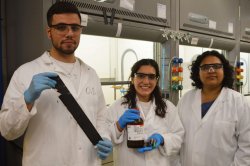A Greener Way to Recycle Batteries
Faculty/student research team discovers safer process using organic solvent
Posted in: Chemistry & Biochemistry, CSAM Research, CSAM Students

Research conducted by Montclair State biochemists has the potential to solve an environmental challenge caused by the disposal of an item many of us use in our everyday lives.
A study by a Montclair State University researcher published in the Royal Society of Chemistry peer-reviewed journal RSC Advances offers a new, more sustainable approach to recycle and recover important components from end-of-life (EoL) lithium-ion batteries (LIBs) that power our cell phones, laptops and electric cars.
Led by Chemistry and Biochemistry Assistant Professor Amrita Sarkar, the research, titled “A Sustainable Approach to Cathode Delamination Using a Green Solvent,” shows that global efforts to increase the use of green, affordable energy sources has resulted in the ubiquity of rechargeable LIBs. Unfortunately, the extensive use also causes an enormous accumulation of battery waste at the end-of-life stage, introducing a serious waste-management challenge that undercuts meaningful sustainability goals.
Researchers and industries are currently looking for sustainable and environmentally friendly techniques of recycling and reusing of spent battery components, Sarkar explains – and this discovery by her team is an important step in that direction.
“This finding is expected to provide a replacement for a toxic organic solvent and offers an effective, eco-friendly and sustainable recycling approach for spent LIBs,” Sarkar says, adding that the method leading to this discovery was tested at lab scale and a pilot-scale test would be necessary to determine its economic viability.
A safer way to recycle
Proper recycling methods are necessary to maintain the sustainability and economic benefits of LIBs and mitigate safety hazards, but so far existing recycling processes typically focus on a combination of physical and chemical approaches that require high temperatures and toxic chemicals.
LIB cathodes – the electrodes that play a central role in moving electrical currents within the battery – also contain active materials such as cobalt and nickel that are wasted in traditional recycling practices, making the need for more effective, sustainable methods increasingly more pressing.
Composed of Sarkar and undergraduate students Onurcan Buken and Kayla Mancini, the research team had a hunch that, by using a commercially available sugar-based solvent called Dimethyl Isosorbide, they could replace the solvent currently used (N-methyl pyrrolidone, which poses unreasonable risks in most of its uses in America) and not only extract more of the elements being wasted, but do it in a greener way.
The results were a significant find – 81% of available active materials like cobalt and nickel and 79% of a critical organic binder, polyvinylidene fluoride, were recovered using the more eco-friendly solvent, far surpassing the amounts recovered using traditional methods.
The results could mean the solving of one of the industry’s most pressing problems, making it all the more important experience for Montclair’s student researchers.
“I am excited to see that my undergraduate research students achieved an impressive feat in obtaining publishable results,” Sarkar says. “They have developed critical thinking, work ethics, communication skills with the outside world and pursuit of excellence for research on par with their graduate peers.”
